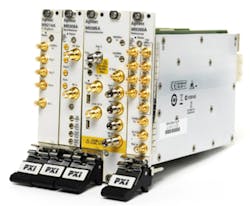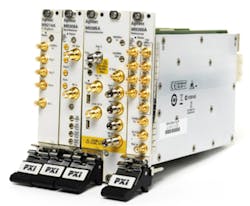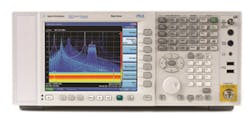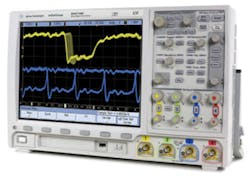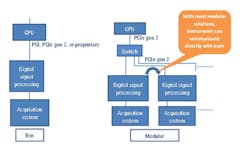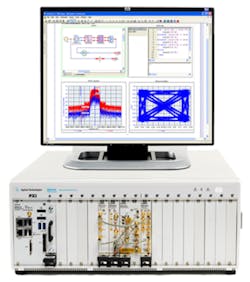As modular test equipment continues to grow in popularity, so have the abundance of myths surrounding the advantages and disadvantages of modular compared to traditional “box” instruments (Figure 1 and Figure 2, respectively).
Myths are often quite fantastic, yet within each myth reality and fiction tend to co-exist. Myths originate to explain complex things in a simpler way, using familiar language and well-understood concepts. Choosing the best test and measurement gear for your application is also a complex thing, so we shouldn't be surprised that myths have formed as a way to simplify the choice.
Agilent has been developing box instruments for over 75 years and modular instruments for over 30 years, and we proudly offer the best of both. Because we know that choosing between the two can be difficult, we thought it would be a good idea to sort the facts from the fiction, to help you make a choice that’s ideal for your application. So, let take a look at some of the myths that have developed and set the record straight.
Myth #1: Modular instruments are inherently less expensive than box instruments.
This myth exists because when you see a box instrument, it looks expensive. You see a complete, self-contained instrument with buttons and a front-panel display, which may be critical in some R&D environments (Figure 3), but are unnecessary overhead in most automated test environments. The expensive elements of modular instruments are more hidden, giving the impression that they may be inherently less expensive. For example, a modern PXI backplane supports 4 GB/s to 18 slots. This adds to the cost in the form of expensive connectors, switches, and backplane material (Figure 4). A chassis that is fully loaded with instruments that all need high-bandwidth connections will fully leverage these costs while providing additional flexibility—thereby resulting in lower costs over its lifetime. But for other applications, these costs are unnecessary overhead. As a result, a PXI system with a single instrument can be 10 to 40% more costly than the same “box” instrument.
Regarding Figures 3 and 4, which one looks more expensive? And where is the truth in myth #1?
While box instruments may be less expensive as a stand-alone item, modular solutions are typically less expensive when multiple instruments are combined into a single chassis. This is due to the fact that the overhead costs can be spread across several instruments. Typically, the break-over point happens with 2-4 instruments in a chassis.
Furthermore, there is a difference between the cost to manufacture the instruments and the price the user pays. Several vendors are entering test and measurement markets with modular approaches. As a way to gain market traction, some of them are willing to lower their price below the market price, eliminating a profit margin, in order to gain share. Of course, this is not sustainable over the long-run.
Myth #2: Modular is inherently able to offer higher throughput.
This myth probably arose because modular systems often have fast backplanes. In reality, the choice of backplane used in a box or modular instrument solution comes down to the need to balance cost and required capabilities for the intended usage. In other words there is no inherent reason why a modular instrument needs to have a faster backplane than a box instrument. The decision is purpose-driven. For example, with a box instrument, it is easier to connect the acquisition part of the instrument to the computing part of the instrument with a high-bandwidth backplane, because only a point-to-point connection is needed.
Meanwhile, with modular, the backplane must support an almost infinite number of combinations of connections. Most modern PXI chassis use PCIe gen 2 to get high throughput across the backplane. While some box instruments use the same PCIe gen 2 for their internal backplanes, buses on box instruments are typically designed to only support the requirements of that particular instrument. For example, PCIe gen 2 would be overkill for a 16-bit, 30-MHz arbitrary waveform generator, so a lower speed, less expensive bus (for example, USB) is typically used for this instrument. Meanwhile, PCIe gen 2 is not fast enough for a 160-GS/s oscilloscope, so a very high speed, proprietary bus is used.
Where is the truth in this myth? There are two aspects of this myth which contain elements of truth.
First, modular backplanes are, indeed, usually quite fast because they are designed to support a range of applications and data-rates. In order for many instruments to communicate quickly with each other, as is generally required of modular solutions, a common/standard backplane is needed. Given that modular infrastructure must meet the needs of a large variety of applications, a high bandwidth backplane standard is typically chosen in order to meet the worst case scenario.
The second element of truth in this myth derives from the fact that modular instrument components can be more easily upgraded, which means that it is usually easier and more cost effective to upgrade whichever part of the modular system is the bottleneck, whereas upgrading the speed of a box instrument may be more difficult. For example, if the CPU is the bottleneck in your modular system, you can easily upgrade it as new PCs enter the market. Similarly, if the analog-to-digital converter is the system bottleneck, a truly modular architecture will enable you to just upgrade the digitizer. So, even if a box instrument and a modular instrument start out with the same speed capability, the box instrument’s speed may be surpassed by the modular instrument as it is upgraded over time.
Figure 5 shows that because modular system components can be upgraded as needed, even if a box instrument and a modular instrument start out with the same speed capability, the box instrument’s speed may be surpassed by the modular instrument as it is upgraded over time.
Myth #3: Modular is higher throughput because it uses binary driver interfaces (for example, IVI) instead of text-based interfaces (for example, SCPI).
There is nothing inherent about modular that requires binary interfaces, and there is nothing inherent about boxes that require SCPI. Some boxes support both SCPI and IVI. Some modular instruments support both SCPI and IVI. The choice often comes down to the applications for which the instrument will be used.
For most applications, the time spent sending and receiving driver commands is a small fraction of the measurement time. This is becoming increasingly true as instrument vendors are working to further abstract measurements for their users. For example, Agilent has “one-button-test” (OBT) applications which can test an entire communication standard (for example, GSM, LTE) with just a few commands. These OBT applications use SCPI to allow the customer to start the test and to retrieve results at the end of the test, but they also use very fast binary communication within the instrument to control the hardware throughout the test. In these cases, the throughput difference for whether the customer uses SCPI or IVI to start the one-button-test is negligible.
What part of this myth is true?
It is true that commands sent over binary driver interfaces, like IVI, are faster than interpreted command interfaces, like SCPI. For applications where there is a lot of communication between the PC and the instrument, the driver interface is more likely to be the bottleneck. This is true regardless of whether the system is modular, or not.
Myth #4: Modular has worse signal fidelity than box instruments.
In most cases, fitting an instrument into a modular form factor does not equate to a hit to signal fidelity. As a matter-of-fact, in many applications, the system-level specs are constrained by the interdependence of more than one instrument working together. Modular often provides better specs for these applications. For example, some applications require very tight instrument-to-instrument skew (for instance, MIMO applications), which can be more readily achieved across a common backplane.
Where is the truth in this myth?
Many applications for which modular solutions are preferred face footprint constraints. For example, modular is popular in some manufacturing applications, where cost per square foot is a significant factor. The truth in the myth lies in the design choices that some vendors make. In size-constrained applications, modular instrument vendors will choose to sacrifice some performance to reduce size. For example, they may use smaller, lower performance oscillators, or they may use less spacing between PCB traces, which causes coupling, and so on. However, this is an instrument design choice and not an inherent disadvantage of modular.
Some modular instruments are partitioned in a way such that various components of the instrument can be more easily upgraded. For partitions across an analog interface, additional cabling may be required, which could have a small impact on performance. Furthermore, calibration of the instrument may be more difficult when parts of the system are upgradeable.
Myth #5: The phrase “modular instruments” refers to modular hardware, not modular software.
When considering modular instruments, most engineers think about PXI, AXIe, VXI, or some other sort of system that involves a chassis and plug-in modules. While a standards-based chassis is certainly an important part of modularity, modular hardware doesn’t provide a lot of value, unless the software and calibration is also modular. For example, Agilent’s M9391A and M9393A PXIe vector signal analyzers are composed of four PXI modules—a clock source, a reference synthesizer, a downconverter, and a digitizer. Figure 6 shows the MP9393A in a chassis, running the Agilent SystemVue software.
The small size of the hardware is interesting, but the real value comes from the fact that the hardware, software, and calibration approach are all modular. For example, these products will allow the customer to upgrade just the clock source in the future in order to provide better phase noise. The driver software has to enable this level of modularity. Similarly, in a traditional box instrument, calibration would happen across all four of these components together, in order to most easily achieve the best performance; however, this approach wouldn’t enable guaranteed performance after the clock source module was upgraded. A different, modular calibration approach is required in order to ensure the advantages of upgradeability, which is an example of why hardware and software are equally important elements of modular instruments.
What part of this myth is true?
It is true that some modular products are really just a traditional box instrument in a modular backplane. For example, some PXI VSAs are not composed of four modules, but rather, they are just one large module that consumes multiple slots on a PXI backplane. The software and calibration of these products were developed with a traditional instrument-level approach. These products do offer the advantages of modular hardware (for example, small footprint and fast instrument-to-instrument connectivity), but they do not allow for the level of upgradeability offered by products that have modular hardware, modular software, and modular calibration, such as the M9393A PXIe VSA.
Conclusion
The differences between modular and box test instruments are subtle, but important. In general, modular has advantages when putting together multi-instrument systems. Purpose-built boxes are great when you need to get the best performance out of a single instrument. Of course, the real world is never that black-and-white. In most systems, you’ll get the best combination of price, performance, and flexibility when you use a combination of boxes and modular instruments. It’s also true that boxes may be better for one phase of your development (that is, testing prototypes), while modular may be better for other phases (that is, system verification). So, if you choose an approach where you can readily transition between boxes and modular instruments, you’ll probably save time and money down the road.
